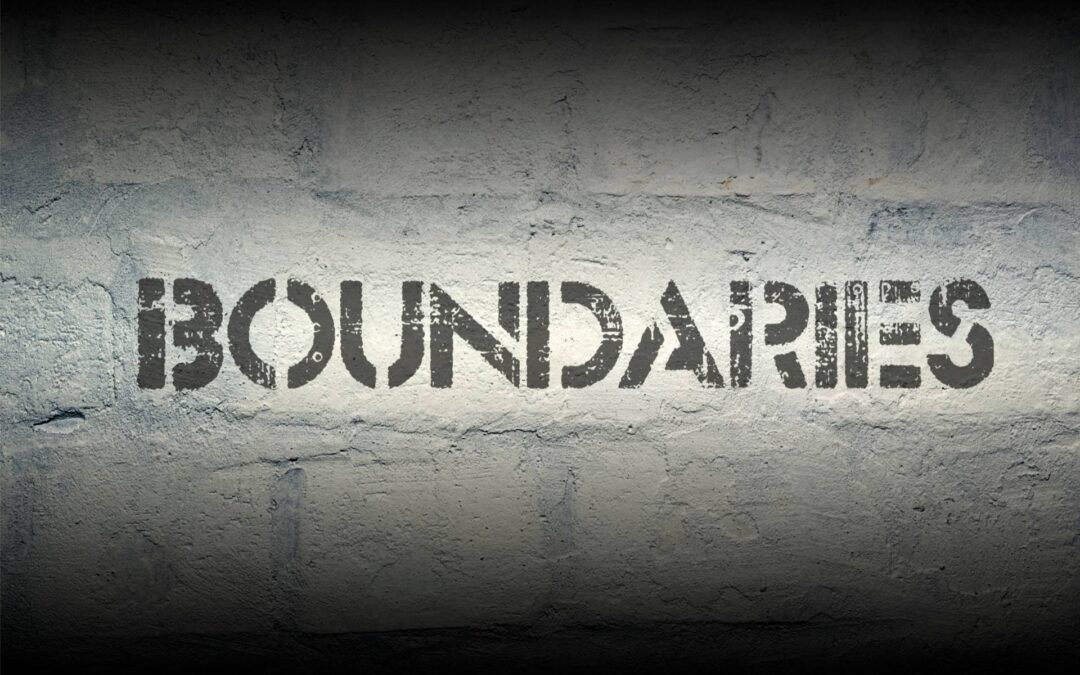Recently I was on a walk with a friend who was complaining about her mother-in-law. “I’ve told her that she’s not allowed to drop by unannounced,” Friend vented, “but she just keeps violating my boundary. I keep setting boundaries with her and she keeps stepping on them. I might have to cut her off altogether.”
Readers, I can’t tell you how many times on any given day I hear family, friends, and clients alike talking about the “B” Word; Setting boundaries, needing better boundaries, what to do when people violate boundaries. Because “boundary” is such a buzz word of late, I thought it might be a good idea to talk about it: what boundaries are, what they aren’t, what purpose they serve, and how to set them.
In the opening example, my friend was mistaken about the transaction she’d had with her MIL. In-law Dearest didn’t, in fact, violate a boundary. She ignored a request. A request implies that another person will or won’t act based on something you ask. A threat attaches a consequence to the action taken or not taken by another. A boundary is something that YOU will do and requires nothing of another person. Examples of boundaries are:
- I will not let you hit me. If you keep hitting Mommy, I will control your body for you until you are able to do it for yourself.
- If you call me after 9pm, I will not answer the phone.
- If you get drunk at the party, I will leave without you.
- If you call me names when we argue, I will no longer participate in the conversation.
What do you notice about the above examples? That’s right: the responsibility lies entirely with the person creating the boundary. This empowers the boundary setter to keep him/her/themselves safe, no matter what the choice of another happens to be.
Boundaries can be physical (I won’t allow myself to be touched without my consent) or emotional (I won’t listen to my racist uncle talk about immigration) and they can be interpersonal (between you and someone else) or intrapersonal (between you and yourself). The point of any boundary is safety; it creates a protective barrier, either literal or figurative, that enables us to remain congruent with our values and maintain peace and self-empowerment. The difficulty with relying on another to foster and maintain these barriers is that, well, people are people. We’re wiley and skittish and want what we want when we want it. Assuming that another person, even someone whom we know loves and respects us, will “honor our boundary,” assumes that another person knows exactly what we need to remain safe and in Self and cares as much about that safety in the moment as we do. And if Mom-in-Law is really needing a grandkid fix, while she’s probably not dropping by out of a desire to violate an emotional need, she’s probably not really considering your needs to begin with.
Sometimes boundaries are communicated directly, like the ones listed above, but some of my favorite boundaries are the ones I create within myself for myself. It’s not always useful or appropriate to simply leave a conversation that I feel is messing with my sense of calm and wellbeing. In those moments, I close my eyes, take a deep breath, and imagine myself surrounded by a sparkly bubble of light. No one can see this bubble but me and it’s warm and safe and impenetrable. If someone is saying something to or about me that doesn’t feel kind or true, I imagine their words bouncing off the bubble and flying far away. Try it: close your eyes and imagine a place you feel most safe and calm in the world. Feel allf the ways that place interacts with your senses: what does it sound, smell, and feel like? Now, create a barrier around yourself such that the yummy, safe feeling is contained around you and everything else is locked outside. Next time you’re in an interaction that feels a bit yucky, recall this visualization. Take a deep breath and say to yourself, “I am in my bubble and no one can fuck with my bubble.”
Someone once told me that resentments are born of boundaries that we haven’t yet set. While it can feel uncomfortable at first to take responsibility for our own physical and emotional safety, especially if we’re new at it (no one used to hearing “yes” all the time likes hearing “no” all of a sudden—you might rock some boats in this process), boundaries are an important tool in maintaining relationships. My boundaries with myself (I will stop eating ice cream after the first bowl because finishing the pint gives me a terrible stomachache) and my boundaries with others (if my office door is shut, I am working and will not answer when you knock) are actually connection-creating rather than connection-hindering. Intrapersonal boundaries foster my own sense of trust in myself, strengthening my ability to take care of me. Interpersonal boundaries also foster self-trust PLUS, they help you understand where you end and I begin, which, even if it makes you upset, helps you to better trust me. Additionally, my boundaries ask nothing of you, giving me both the power and the responsibility to maintain my peace and safety. This means I’m not harboring anger or frustration at you for not abiding by a request or ignoring a threat, which rids our relationship of the murky under-the-surface tension that poisons true connection.
There’s a reason why so many people are throwing around The B Word lately. Good boundaries truly are the cornerstone of healthy relationships. I hope that reading this has given you a clearer understanding of what they are and how to create them. Remember: it’s all about you and your choices, stay strong even when folks push against them, and remember your Bubble. No one can mess with your Bubble.

